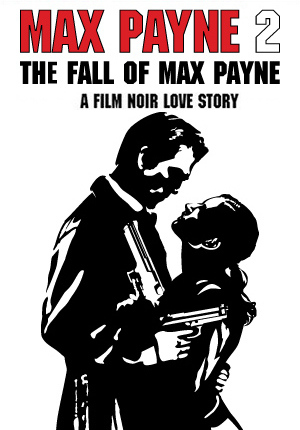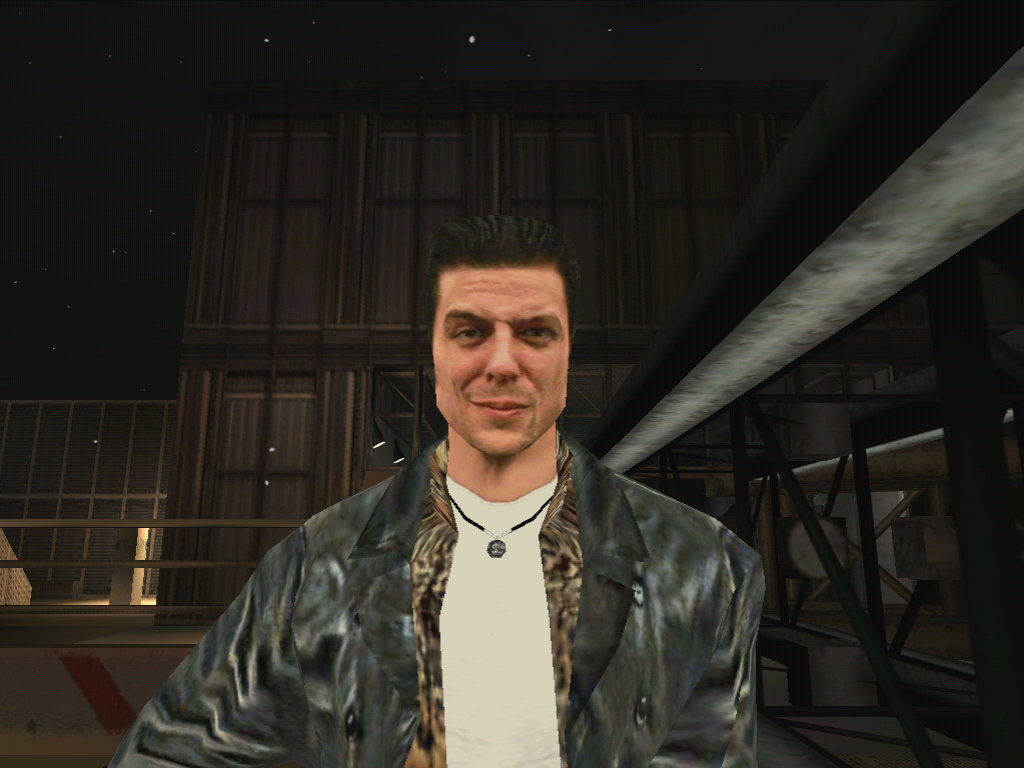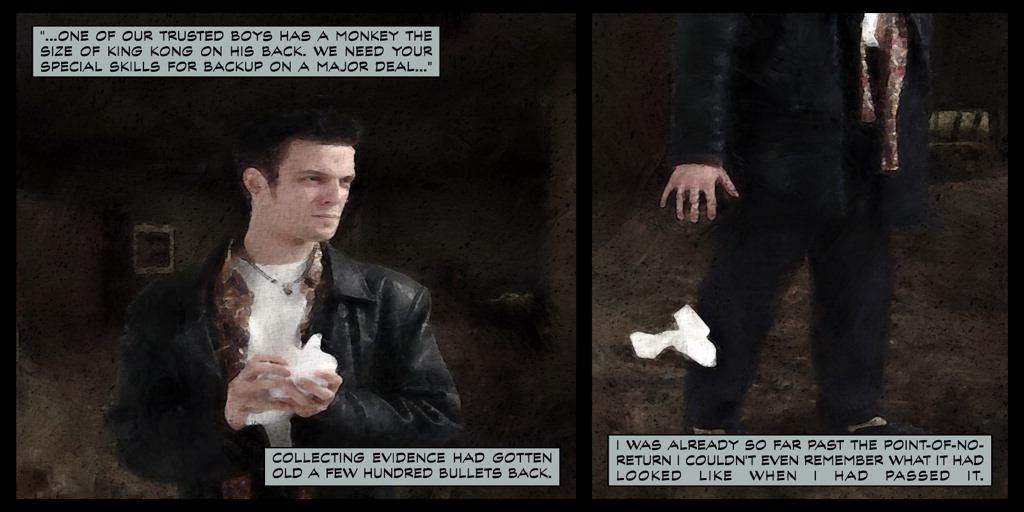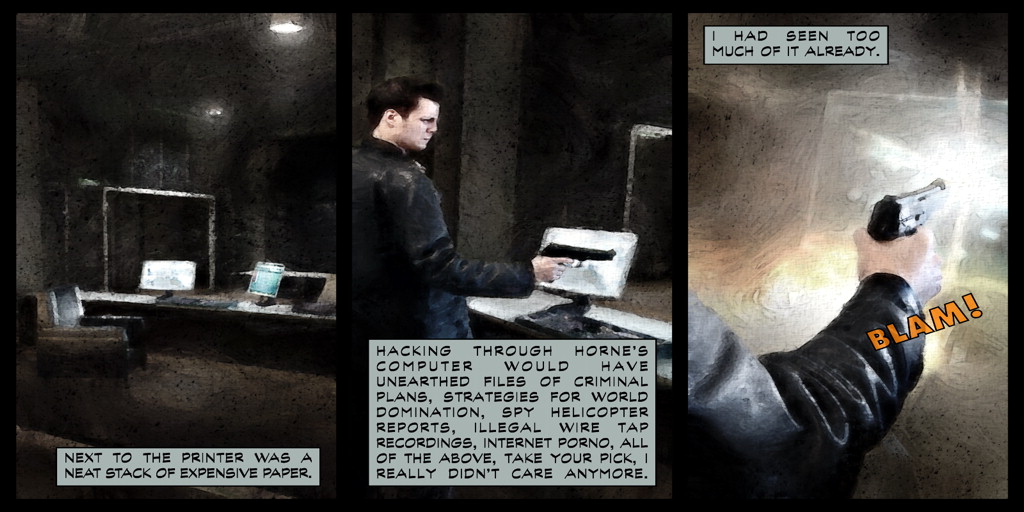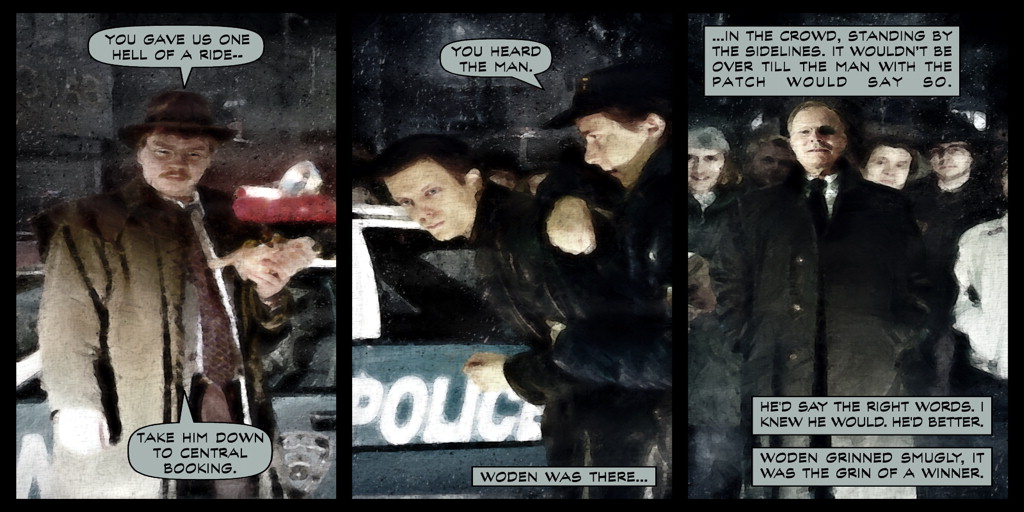Last updated on October 29, 2013
NOTE: Obviously plot spoilers for both games up ahead. You have been warned.
Max Payne 2 establishes its tone from the very title screen. Whereas the first game gives a lowbeat techno main theme:
Max Payne 2 uses a much more affecting, emotional, and sad funeral dirge:
http://youtu.be/omQ-7wZTXvI
You wouldn’t think such a minor thing would vault one game over the other. Max Payne was always about mood, style, and tone – any one with knowledge of American pop culture has to know the film noir style, which drips with cynicism and drama. From the opening notes, Max Payne 2’s music embodies all of these elements in equal measure.
Remedy has a stunning game on its hands. Max Payne 2 simply exceeds the first in every way and really defines what a sequel should do, enhancing both the game mechanics themselves and the story attached. Remedy’s masterpiece not only plays noir conventions, but also takes advantage of its sequential status to drop references to the first game’s story and complicate a rather simple narrative. It concludes it in an extremely satisfying way, equal parts closure and redemption, fall and rebirth (making me suspect of Max Payne 3, but we’ll see). Furthermore, it’s such an improvement over the first game’s innovative bullet-time concept, taking it to the next level in both graphical capabilities and in stylishness. There’s no padding; it’s taut, focused, and does exactly what Remedy wants it to do.
Knowledge of the first game is pretty much required. Told primarily in graphical novel and in-game voiceover, Max Payne became an endearing personality even under the utter horror of having his wife and daughter killed by drug addicts. Is this because he’s an invincible anti-hero? Not at all! Due to the fantastic writing of Sam Lake, we’re giving a glimpse at what could drive a man to the heights of vigilante justice in part; a host of witty one-liners and creative insults from Payne himself don’t hurt. Still, he’s a bit of a cardboard cutout, an invincible video game hero who, though tainted with a cynical edge, isn’t anything more than a caricature.
Or is he? There’s a certain psychological bravado to Max, just brimming underneath the surface. The best way to deal with the death of loved ones, especially in a way that seems “wrong”, is to push those feelings down deep where they can’t be found. He’s playing it Bogart, as a million movie heros and video game ones alike have done a million times before, but something’s different here. Is he really seeking justice, or answers, or anything akin to a rational conclusion? No; it’s just an expression of his pain – hence the last name. When the spree finally ends, even a retrospective look doesn’t make sense of it.
They were all dead. The final gunshot was an exclamation mark to everything that had led to this point. I released my finger from the trigger. And then it was over. To make any kind of sense of it, I need to go back three years. Back to the night the pain started.
It was over, indeed; Max Payne had killed Nicole Horne, CEO of the Aesir Corporation and the woman responsible for his family’s death through a secret government project. The drug called “V” turned its subjects into psychotic, belligerent, and crazed people. Project Valkyrie was a government project responsible for the creation of the drug; it was discontinued after seeing its effects by the Inner Circle, a secretive cabal who controlled the incognito. Horne, refusing to listen, doubled the dosage on “test subjects” and continued research in an “urban” environment even after it was discontinued. Payne’s wife, an employee of Aesir, was in the wrong place at the wrong time. She became a little too inquisitive, and Horne sent some V addicts to the Payne residence.
Not that any of this mattered to Payne:
And:
The only solution was murder. Violence. No second chances, just cold hard revenge on anything and anyone standing between Max and his answers. These lowlifes he kills “deserve it” in a sense; after all, they’re criminals and cheats, lawbreakers and reprehensible human beings. Max, in the end, becomes as horrific as the people he destroys. Even after his murderous spree, he came out a hero in the public due to the influence of Inner Circle member Alfred Woden, who basically forces Payne to kill Horne.. Max Payne was arrested for obvious reasons after the deed was done (hey, if you’d kill a thousand people in one night, I’d imagine you might be incarcerated as well). It didn’t matter:
The Max Payne of the original is supposedly shallow in this respect. Although his wife and child dies, and we have frequent visions (provoked by drugs) of his pain and guilt, the ending doesn’t give much sense that this whole conflict was anything other than a personal war. When Payne finally finishes Horne off, he’s the winner and she is the loser, end of story. There’s not much more to it than that, and it’s somewhat disappointing that they couldn’t have ended the story on a more consistent note. For a game so highly rated back in its day, the narrative’s weird inconsistencies stand out to me. I’m going to guess not many people have played the original in the past eleven years (as you’ll see why in Part 2).
Supposedly is the key word in the first sentence above. Little did I know that the second game was obviously planned for this plot contingency, to reveal what we were missing in the first place.
Even so, the first game has obvious flaws, both in plot and mechanics. The gunplay itself is quite “video-gamey” as well. Although the bullet-time remains enjoyable, certain points of the game drag. Most mainstream press describe Max Payne as “repetitive”, and while I understand their concerns, it isn’t repetition so much as it is pacing. You can have the most simplistic, repetitive mechanics in the world and still make them fun if the level design supports that mechanical cornerstone. In Payne’s case, bullet-time could carry a whole game by itself if used correctly. A game engenders certain expectations; you hope the developers present interesting situations for you to use the tools they provide. Bullet-time, in that respect, creates high expectations for what setpiece the developers will throw at you next. It’s unforunate that the original Max Payne hasn’t aged well in this respect.
Much of the level design is fine; I get that Max Payne’s searching the underworld for answers, including mob locations like love hotels, industrial buildings, factories, docks for arms deals, etc. However, it’s the way the enemies react and respond that bring you out of the experience. Like many PC games, I imagine, the game has AI react when the player crosses some imaginary line or door; once they do, enemies know you’re there and won’t stop trying to kill you until somebody dies. Sometimes, you’ll see a grenade fly by you, and you’ll know you crossed it. That’s fine when you don’t expect it when you hit these arbitrary points, but repeating a segment takes the fun out of the fight. You can really abuse it by running past the line, then back through a door – most guys are too dumb to know any better, and they’ll follow you into the room, making for easy pickings. It’s a shame there weren’t better ways to program them.
There’s a bigger problem with levels, though: memorization. Sometimes, you’ll open a door, get blown away by an enemy and die. Is that fun? Not really. There’s a difference between a death to which I can react and one that just happens out of the blue. This becomes more and more frequent, and sometimes even bullet time can’t save you from instant death; you’ll try to open doors and just throw grenades in there to hopefully flush out the enemies on the other side. The action setpieces don’t work as well as you’d hope because of this. Many of them take places in hallways or giant empty stadium like rooms – good luck finding out where that sniper is before he pegs you in the head. Wide open areas spell death for pain, but there’s lot of them! I’m not sure why they thought this was fun, especially as many weapons don’t do much damage from a distance except the sniper rifle (hard to use in a firefight) and the Colt Commando (which you get half way through the game, and become the go-to weapon for the majority). It’s a notable problem, but memorization fixes it. Like a good shmup, except in 3D, Payne wants you to memorize – but this is supposed to be realistic! The narrative isn’t supported by the arcade action – it breaks immersion again and again.
There’s additional ways that Max Payne breaks your immersion. Firstly, the shootdodges are the only useful way of dispatching enemies effectively. Regular bullet time, done by pressing the button when standing still, isn’t useful at all and takes a great deal of your Adrenaline (the BT meter). You must dodge, or you will die. This might not seem a big problem until you see the later groups of enemies; many have shotguns and rifles, and three to four enemies won’t hesitate to drop Payne in two seconds flat. If you can’t kill every enemy by the time you land, you’re screwed. You end up dodging around an area like a maniac, and it’s just odd looking. If you have the PC version, just quicksave often; if you’re on a console version of the game, good luck completing each stage like that! Because of this, I found that I would repeat sequences over and over again to get just the right amount of health and painkillers (which restore health) to finish the next part. It’s not that I am angry that I can’t complete these perfectly in one go; it’s that challenge has been replaced by incredibly damaging situations that you can’t escape. It’s unfair in all the wrong ways.
Let me replicate a situation for you: there’s a sequence in the last part (Part III) where a cutscene plays. Immediately after this, you’re beset by four guards, two with machine-gun style shotguns (called Jackhammers, fittingly enough) and two guys with Colt Commandos. The moment the cutscene ends, they starting shooting at you; you must shootdodge immediately, hopefully take out two people, then land and kill the other two. This might seem simple, but I replayed this sequence approximately 20-30 times or so. It doesn’t help that, to make up for dumb AI, Remedy made every enemy (contextually relevant or not in the story) a master marksman and super-humanly resistant to bullets in the head. If you’re shooting for realism (har har), having headshots as a minor inconvenience doesn’t add to the immersion. Seriously, if you hide behind an object, they’ll still be able to hit any body part that stick out almost immediately. This goes for the “peek-a-boo” moments when enemies are behind doors as well; you always die if that happens.
Best of all, shooting for Max Payne isn’t all that accurate. There are more times than I can count where a shot that I thought was entirely successful swooshes right by an enemy’s head – then, he shoots and kills me. This happens especially at close range; somehow, with a shotgun of all things, you can shoot at point blank and still miss a guy entirely for no comprehensible reason. Not that the AI has the problem; they’ll be happy to punish you for a mistake that wasn’t your fault, over and over again. This happens in bullet-time as well, and shootdodging becomes all the more risky because of it. There’s no point in this game where you should duck and hide behind cover, yet I found myself doing this more than I should. Grenades, as well, work inconsistently; it may explode next to an enemy and he’ll barely move, but have one detonate near you and you WILL take damage. It’s odd and inconsistent.
Shootdodging for certain weapons is entirely impossible. Try using the Pump-Action Shotgun; you get one shot off in the time you’re in the air, and then Payne makes a happy dive into the floor without firing another until he gets off the ground. This means that certain weapons completely outlive their usefulness in the course of the game, not only because they’re worthless in the game’s main mechanic, but also because enemies are simply too damage resistant to allow them any quarter.
I’m up for a good challenge, but parts of this game were borderline ridiculous. It’s as if the quicksave function was NECESSARY, simply because the developers couldn’t balance the difficulty level correctly. Supposedly, the game takes note of how good you are doing and adjusts the difficulty dynamically, but that doesn’t appear to work that well; most enemies were difficult to defeat and that only escalated. It could be a part of the quicksave feature prevent the dynamic shift, but you need quicksave to play the game. Heck, how would you ever complete this on console? Maybe it has a quicksave function as well (if anyone knows, please tell me), because memorizing entire levels would be tedious at best.
My biggest complaint, however, stems from the lack of connection between the narrative and the game. We’re talking about a video game here: graphics novel scenes with dialogue and sound effects help a great deal (watch some of them here and tell me it isn’t well done), but the narrative rarely takes advantage of the fact that this is a video game. Why not also have a graphical novel art style as well? Granted, it was 2001, but games of the same time period had done that already (Jet Set Radio, anyone?). The two elements never really mix well. There are sequences where Remedy was intent on combining them; this happens in the dream sequences, or drug trips where Max Payne’s feelings of guilt and paranoia manifest themselves in freakish imagery, the sound of a heartbeat, mysterious voices and the cries of a dying infant (headphones are a must). They’re effective, but for the fact that you can die in them, along with jumping in complete darkness and traversing mazes, makes for an exercise in frustration rather than fun. You can see what they were going for, but it doesn’t happen here.
I’ve been talking about the first game as if it’s horrible, but that’s not my intention. I honestly enjoyed it and I liked the challenge, even if it was the frustrating kind at points. Max Payne, though exemplary and fun for the concept and originality, fall short in a number of areas. Remedy, though, showed that they were skilled and talented; they could create a sequel worthy and able to execute the concept with a second chance.
Thus, we have Max Payne 2: The Fall of Max Payne – an improvement in every fashion.
Proceed to Part 2

